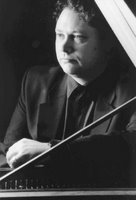Googling the Goldbergs
The internet is a wonderful and extraordinary world. Google ‘goldberg variations’ if you will. At the time of writing there were 580,000 results (nearly 3 times as many as for Beethoven’s Missa Solemnis, and over twice as many as for his 9th symphony).
 From Richard Egarr's notes for his new recording of the Golbergs played on a reproduction Ruckers instrument voiced with quill, tuned to musicologist Bradley Lehman's 'Bach temparement', and including all the repeats, plus the rarely heard 14 Canons on the Ground from the Goldberg Variations, BWV 1087. These were discovered in 1974, and Egarr plays both voices in the canons using double-tracking. The sound, from the Dutch venue of the Vereenigde Doopsgezinde Gemeente in Te Haarlem, is demonstration quality.
From Richard Egarr's notes for his new recording of the Golbergs played on a reproduction Ruckers instrument voiced with quill, tuned to musicologist Bradley Lehman's 'Bach temparement', and including all the repeats, plus the rarely heard 14 Canons on the Ground from the Goldberg Variations, BWV 1087. These were discovered in 1974, and Egarr plays both voices in the canons using double-tracking. The sound, from the Dutch venue of the Vereenigde Doopsgezinde Gemeente in Te Haarlem, is demonstration quality.
The CD set includes an abbreviated version of Richard Egarr's excellent notes, you can read the full version online at the Harmonia Mundi website, including details of the tuning system used, via this link. And incidentally Egarr (photo above) doesn't mention in his notes that there are more than 100 recordings of the Goldbergs in the catalogue. But, despite that, his new version is a valuable, and recommended, addition. And interestingly, despite the repeats, it is not the longest at 83 minutes. Glen Wilson (Teldec), Sergio Vartolo (Tactus), and Igor Kipnis (EMI) all take the same time as Egarr, or longer. This new version spans two CDs, but Harmonia Mundi are pricing it as one.
Report broken links, missing images and other errors to - overgrownpath at hotmail dot co dot uk
If you enjoyed this post take An Overgrown Path to Messiaen stars in early music festival
 From Richard Egarr's notes for his new recording of the Golbergs played on a reproduction Ruckers instrument voiced with quill, tuned to musicologist Bradley Lehman's 'Bach temparement', and including all the repeats, plus the rarely heard 14 Canons on the Ground from the Goldberg Variations, BWV 1087. These were discovered in 1974, and Egarr plays both voices in the canons using double-tracking. The sound, from the Dutch venue of the Vereenigde Doopsgezinde Gemeente in Te Haarlem, is demonstration quality.
From Richard Egarr's notes for his new recording of the Golbergs played on a reproduction Ruckers instrument voiced with quill, tuned to musicologist Bradley Lehman's 'Bach temparement', and including all the repeats, plus the rarely heard 14 Canons on the Ground from the Goldberg Variations, BWV 1087. These were discovered in 1974, and Egarr plays both voices in the canons using double-tracking. The sound, from the Dutch venue of the Vereenigde Doopsgezinde Gemeente in Te Haarlem, is demonstration quality.The CD set includes an abbreviated version of Richard Egarr's excellent notes, you can read the full version online at the Harmonia Mundi website, including details of the tuning system used, via this link. And incidentally Egarr (photo above) doesn't mention in his notes that there are more than 100 recordings of the Goldbergs in the catalogue. But, despite that, his new version is a valuable, and recommended, addition. And interestingly, despite the repeats, it is not the longest at 83 minutes. Glen Wilson (Teldec), Sergio Vartolo (Tactus), and Igor Kipnis (EMI) all take the same time as Egarr, or longer. This new version spans two CDs, but Harmonia Mundi are pricing it as one.
Report broken links, missing images and other errors to - overgrownpath at hotmail dot co dot uk
If you enjoyed this post take An Overgrown Path to Messiaen stars in early music festival









Comments
Follow this link for the full press release.
Can any reader tell me where he finds enough sea gull feathers to voice a harpsichord?
Or is there a clandestine cull of sea gulls to meet the demands of the early music industry?